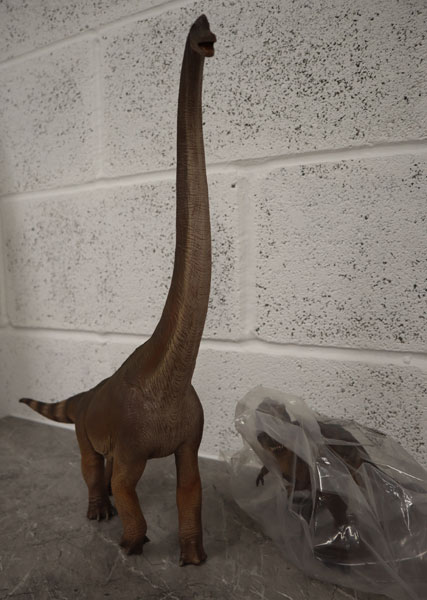New Study Explores the Movement of Sauropod Tails
Locomotion in the Sauropoda is hotly debated by palaeontologists. Some of these leviathans grew to enormous sizes. Once thought to have been semi-aquatic, scientists have a better understanding of their anatomy, and most academics concur that these reptiles were well-adapted to a terrestrial existence. How these animals moved their enormous bulk has been the subject of numerous scientific papers. In a new study, researchers have examined the caudal vertebrae of the giant Giraffatitan brancai to gain a better understanding of tail mobility. This research, published in the journal “Royal Society Open Science” provides fresh insights into the biomechanical properties of one of the largest dinosaurs known to science.
The study analysed eighteen preserved tail vertebrae from a nearly complete tail of Giraffatitan brancai. Excavated from Upper Jurassic deposits in Tanzania, these fossils are in the collection at the Museum für Naturkunde Berlin.

A model of Giraffatitan brancai. The W-Dragon Giraffatitan Compared to a Papo standing T. rex dinosaur model. Picture credit: Everything Dinosaur.
Picture credit: Everything Dinosaur
The tails of archosaurs are important. They have a biomechanical function and assist with movement. In addition, they function as behavioural tools helping animals to communicate and interact with their environment. Until recently, tails have been neglected in biomechanical analyses and were considered as a stiff (sometimes independent) unit. However, the tail’s role in movement is now increasingly being appreciated.
Testing the Movement of Individual Giraffatitan brancai Caudal Vertebrae
New kinematic programmes were used to test the movement of the individual caudal vertebra in relation to each other. The scientists wanted to explain the impact of forces on the muscles. Furthermore, they wanted to pinpoint areas of muscle attachment on the tail bones. From this, they set out to determine the mobility and movement of the dinosaur.
Corresponding author, Dr. Verónica Díez Díaz (Museum für Naturkunde Berlin), explained:
“Our analyses show that the tail of Giraffatitan was much more mobile and functionally versatile than previously assumed.”
A detailed analysis of the so-called haemal arches was undertaken. These haemal arches are bony structures on the underside of the tail vertebrae. They were often overlooked in earlier studies. In this new study, the researchers conclude that these elements had a significant influence on the mobility of the tail.

Diagram of specimen number MB.R.2921 caudal series of G. brancai, left, with (green) intervertebral discs between vertebrae. Colour coded computer model (right) testing the flexibility of the caudal vertebrae. Picture credit: Díez Díaz et al.
Picture credit: Díez Díaz et al
Employing Sophisticated Computer Models
The use of sophisticated computer models confirm that the Giraffatitan exhibit at the Berlin Natural History Museum is accurate. Sauropods did not drag their tails behind them like crocodilians. Instead, the carried their tails raised off the ground. Furthermore, Giraffatitan could move its tail flexibly in several directions.
This study provides new information on the posture, movement and possibly the social interactions of these massive dinosaurs. The study not only offers new perspectives on the anatomy of macronarian sauropods, it also provides valuable impetus for future reconstructions and palaeobiological interpretations.
Everything Dinosaur acknowledges the assistance of a media release from the Museum für Naturkunde Berlin in the compilation of this article.
The scientific paper: “Centres of rotation and osteological constraints on caudal ranges of motion in the sauropod dinosaur Giraffatitan brancai” by Verónica Díez Díaz, Pasha A. van Bijlert, William Irvin Sellers, Mathew J. Wedel and Daniela Schwarz published in Royal Society Open Science.
The award-winning Everything Dinosaur website: Dinosaur Models and Figures.

